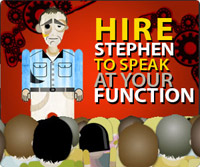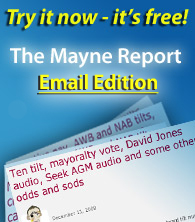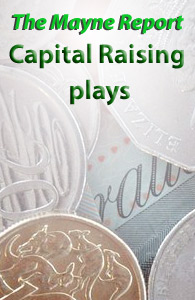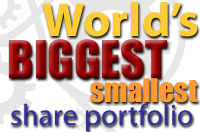Winning from the floor at Alumina
May 2, 2008
Dear Mayne Reporters,
The Melbourne old boys club that have so mismanaged Australia's great resources dowry copped one in the eye today when yours truly was convincingly elected to the board of the $6.8 billion Alumina Ltd in a show of hands from the floor of the AGM at Jeff's Shed.
The 200 largely elderly punters clearly warmed to this campaign speech, which we're only able to bring you courtesy of the webcast because Alumina took a leaf out of Rio Tinto's book and refused me entry with a pocket recorder. Why you'd ban someone recording something that is being webcast remains a mystery?
As usual, the institutions didn't bother to show up and listen to the debate. They largely voted against the challenger following the advise of the all-powerful proxy advisers, Risk Metrics and CGI-Glass Lewis, neither of which bothered to call to inquire more about this platform in the notice of meeting:
Stephen Mayne, age 38. Bcom (Melb). Stephen Mayne is a Walkley Award winning business journalist and Australia's leading shareholder activist. For four years he has been arguing that the six-man Alumina board is too big and paid too much for a post box company with just a handful of employees. He also believes Alumina needs to take global warming and sustainability issues more seriously, especially with wall-to-wall Labor governments in Australia.
The meeting lasted for two hours and the case against the board was built progressively as we worked through the resolutions.
Chairman Don Morley required shareholders to ask all of their general questions in one batch, so my opening offering covered the cost of running this post box company, carbon emissions and the heavily subsidised Portland Aluminium Smelter.
Morley admitted that the company was now costing $12.6 million a year to run, when the figure was only $8 million in 2003 and $3.5 million when the 40% stake in the AWAC joint venture was held within WMC.
My whole complaint for the past five years has been that Alumina doesn't need 5 non-executive directors costing $1 million a year and a CEO, finance director and company secretary costing $3 million a year when it does nothing more than hold a 40% minority interest in a global alumina, bauxite and aluminium business that is run by Alcoa out of Pittsburg.
Indeed, this letter from Alcoa CEO Alain Belda to former WMC CEO Hugh Morgan in November 2001 spells out the situation pretty clearly and I quoted this extract to the meeting during the debate about the remuneration report:
WMC only holds a 40% minority interest which is subject to Alcoa's virtually complete control, is subject to an absolute prohibition on transfers to a certain class of buyers and is further subject to Alcoa's right of first refusal in the event of a proposed transfer to any buyer. On the subject of dividends WMC has a vote if AWAC proposes to distribute less than 30% of annual net income, but not otherwise. Moreover, Alcoa's control and management rights will remain completely unaffected by your proposed demerger.
So what exactly have Alumina shareholders got from the $50 million they spent administering the 40% holding over the past 5 years when the share price has only edged higher from $4.60 to $5.60, despite a global resources boom?
Board fees have certainly risen much more quickly than the share price. Chairman Morley was on $212,500 in 2003 but this has now risen 49% to $316,572 in 2007. The other four directors - including outgoing 70-year-old Mark Rayner who notched up triple-disasters as chairman of NAB, Pasminco and Mayne Nickless - all started on $85,000 but are now taking home $131,881, a hefty rise of 54% in five years.
Remuneration report and CEO debate
The remuneration report copped a 42% no vote last year so remuneration committee chairman Ron McNeilly, a 40 year veteran of BHP before he was retrenched after the Billiton merger, gave a speech stressing the consultation with institutions and subsequent changes to the incentive arrangements for CEO John Marlay.
This seemingly did the trick with institutions as the against vote was back to single digits this year. The proxy advisers and instos clearly felt all puffed up and important after the "consultation" but they failed to look at the bigger picture - why does Alumina need a CEO at all?
It was only on Monday when Alumina announced that Marlay was leaving and would be replaced by BOC executive John Bevan on an identical package to that which cost shareholders $1.5 million last year.
I made the point that appointing former Alcoa number two John Pizzey to the board in June surely offset the need for a new CEO because he would be able to ring his old Alcoa mates and ensure us minority AWAC shareholders weren't being done over in any way. Finance director Ken Dean could have been bumped up to Alumina CEO because even he doesn't have to do that much for his $854,000 a year.
Alas, we've got a new CEO whose job will be to watch Alcoa run the business, give speeches, lobby politicians, have 14 board lunches a year, ensure the 10 staff are happy and hope that Alcoa wakes up one day and decides to lob a $10 billion bid on the table.
Climate change skepticism
The new CEO's position on climate change will be interesting because Alumina and John Marlay in particular were big players in Australia's climate change denial industry. Marlay is chairman of the Australian Aluminium Council and today chairman Morley gloated about being one of the founding members of the Australian Industry Greenhouse Network, the group which drove John Howard's implacable climate change denialism ever since the decision not to sign Kyoto.
I asked one greenhouse expert and author about Alumina last night and he emailed through the following:
As Alumina is a child of WMC which openly supported the ultra-sceptic Lavoisier Group I think you are on pretty safe ground giving them a gee-up. Not surprisingly, Alumina had the inside running as a member of the task group overseeing Howard's emissions trading report in 2006-07, and as I recall they reportedly had good informal access to Howard as well. They are not involved with the AIGN (aka the greenhouse mafia) and are indirectly represented through one of the hardest core members, the Australian Aluminium Council. Their interests would also be advanced by Alcoa (their partner in AWAC) which has been one of the most consistent players working to delay action in Australia and the US (driven in part by sceptic diehards Sir Arvi Parbo and Hugh Morgan). It doesn't look like Alumina made a separate submission to the Garnaut process, but I would be amazed if they took a different line to the AAC and the AIGN which is carve-out provisions essentially for all aspects of the aluminium production process as I read it - shift the burden onto consumers and other sectors of the economy.
When it came to the campaign speech, I pointed out that the Alumina board now comprised six blokes with an average age of 64, who had sod all understanding of the Labor and green politics now driving the climate change debate.
CEO John Marlay was smart to tell his board he wanted to move on just a few days after John Howard's defeat. His time was over and Alumina needs new blood that can move behind a strategy of deny and delay.
They've got a new CEO but the same tired old Cold War warriors remain on the board, led by Hugh Morgan's long time finance director Don Morley, who is now 68.
The final poll result
The meeting finished at 1pm but it took Alumina until 5.21pm to produce these proxies and poll results for the ASX.
On the proxies, I only got 44.5 million in favour and 664 million against so a primary vote of just 6.2% was never going to be over-turned in the poll which served up a final vote of 44.63 million in favour and 683.93 million against, which included about 19 million open proxies held by the chairman.
That said, it was remarkable to see Morley stumble and fumble his way through the poll process after erring in declaring the resolution on my election had been carried. Have a listen here. His final conduct of the poll also wasn't too flash.
John Pizzey came over for a friendly chat after the meeting as we're both old Ivanhoe Grammar School boys and I know his children. We even made a couple of gags about this during the meeting.
Don Morley also came over for a chat and I promised him a year off next year because this year's tilt was actually a broken promise. I bumped into Morley and his wife at the Mark Steyn dinner put on by the IPA and they promised to vote for me in the 2006 Victorian election if I didn't front the 2007 Alumina AGM.
Not knowing that they'd fulfilled the promise, I duly turned up last year and then promised to give him a break in 2008. Alas, I ended up running for the board and he was good enough not to mention this broken promise to shareholders today.
The response from shareholders after the meeting was very warm and the board certainly were sent a very strong message. We've edited down the key audio exchanges so take the time to listen because this was one of the best examples of shareholder pressure at work.
The biggest ever win from the floor in 30 tilts has set this board back on their heels, so let's just hope the institutions and mainstream press do their bit to really send the message home.
Shouting out to Cathy Walter
In one final amusing anecdote, I was driving the nanny's clapped out old Toyota up Little Collins Street behind the RACV Club after the meeting and spotted former NAB director and current James Hardie director Cathy Walter walking down the street.
Having twice run against Cathy at NAB and ASX in 2000, I wound down the window and yelled out: "Hey Cathy, I've just been elected to the Alumina board."
She looked startled but smiled approvingly because I added: "That was on the show of hands, I lost in the poll."
Oh well, you can only dream and enjoy being a director vicariously through the missus up here at the RACV where this report is being filed from.
Press coverage
As usual, the press coverage of all the AGM action was very limited, even though Alumina is one of the 10 biggest Melbourne-based companies. Sky News simply ran an extended interview with Alumina CEO John Marlay after the meeting, The Australian ran some Dow Jones wire copy that was written off the formal addresses, The AFR was missing in action and only The Age actually noted the big protest from the floor with this piece by Mark Hawthorne and an earlier online story from AAP.
I gave the proxy advisers and institutions a solid cuffing in this Crikey story and we also made this video about the meeting.
Our previous Alumina AGM coverage
Tackling the Alumina lunch club in 2008 Mayne Report, February 9, 2008
Enough Alumina talk, time for action Mayne Report, January 18, 2008
Another crack at the post office box company and its lunch club board Crikey, April 27, 2007. Listen to edited audio.
Inside the Alumina lunch club Crikey, April 26, 2006
20 meetings a year and a pay rise for Alumina lunch club Crikey, April 27, 2005
No credit for opening salvo at Alumina in 2003 Crikey, May 5, 2003
Alumina protest and what to tell a room full of Christian Kerr critics Crikey, May 8, 2007
Do ya best, Stephen Mayne
The Melbourne old boys club that have so mismanaged Australia's great resources dowry copped one in the eye today when yours truly was convincingly elected to the board of the $6.8 billion Alumina Ltd in a show of hands from the floor of the AGM at Jeff's Shed.
The 200 largely elderly punters clearly warmed to this campaign speech, which we're only able to bring you courtesy of the webcast because Alumina took a leaf out of Rio Tinto's book and refused me entry with a pocket recorder. Why you'd ban someone recording something that is being webcast remains a mystery?
As usual, the institutions didn't bother to show up and listen to the debate. They largely voted against the challenger following the advise of the all-powerful proxy advisers, Risk Metrics and CGI-Glass Lewis, neither of which bothered to call to inquire more about this platform in the notice of meeting:
Stephen Mayne, age 38. Bcom (Melb). Stephen Mayne is a Walkley Award winning business journalist and Australia's leading shareholder activist. For four years he has been arguing that the six-man Alumina board is too big and paid too much for a post box company with just a handful of employees. He also believes Alumina needs to take global warming and sustainability issues more seriously, especially with wall-to-wall Labor governments in Australia.
The meeting lasted for two hours and the case against the board was built progressively as we worked through the resolutions.
Chairman Don Morley required shareholders to ask all of their general questions in one batch, so my opening offering covered the cost of running this post box company, carbon emissions and the heavily subsidised Portland Aluminium Smelter.
Morley admitted that the company was now costing $12.6 million a year to run, when the figure was only $8 million in 2003 and $3.5 million when the 40% stake in the AWAC joint venture was held within WMC.
My whole complaint for the past five years has been that Alumina doesn't need 5 non-executive directors costing $1 million a year and a CEO, finance director and company secretary costing $3 million a year when it does nothing more than hold a 40% minority interest in a global alumina, bauxite and aluminium business that is run by Alcoa out of Pittsburg.
Indeed, this letter from Alcoa CEO Alain Belda to former WMC CEO Hugh Morgan in November 2001 spells out the situation pretty clearly and I quoted this extract to the meeting during the debate about the remuneration report:
WMC only holds a 40% minority interest which is subject to Alcoa's virtually complete control, is subject to an absolute prohibition on transfers to a certain class of buyers and is further subject to Alcoa's right of first refusal in the event of a proposed transfer to any buyer. On the subject of dividends WMC has a vote if AWAC proposes to distribute less than 30% of annual net income, but not otherwise. Moreover, Alcoa's control and management rights will remain completely unaffected by your proposed demerger.
So what exactly have Alumina shareholders got from the $50 million they spent administering the 40% holding over the past 5 years when the share price has only edged higher from $4.60 to $5.60, despite a global resources boom?
Board fees have certainly risen much more quickly than the share price. Chairman Morley was on $212,500 in 2003 but this has now risen 49% to $316,572 in 2007. The other four directors - including outgoing 70-year-old Mark Rayner who notched up triple-disasters as chairman of NAB, Pasminco and Mayne Nickless - all started on $85,000 but are now taking home $131,881, a hefty rise of 54% in five years.
Remuneration report and CEO debate
The remuneration report copped a 42% no vote last year so remuneration committee chairman Ron McNeilly, a 40 year veteran of BHP before he was retrenched after the Billiton merger, gave a speech stressing the consultation with institutions and subsequent changes to the incentive arrangements for CEO John Marlay.
This seemingly did the trick with institutions as the against vote was back to single digits this year. The proxy advisers and instos clearly felt all puffed up and important after the "consultation" but they failed to look at the bigger picture - why does Alumina need a CEO at all?
It was only on Monday when Alumina announced that Marlay was leaving and would be replaced by BOC executive John Bevan on an identical package to that which cost shareholders $1.5 million last year.
I made the point that appointing former Alcoa number two John Pizzey to the board in June surely offset the need for a new CEO because he would be able to ring his old Alcoa mates and ensure us minority AWAC shareholders weren't being done over in any way. Finance director Ken Dean could have been bumped up to Alumina CEO because even he doesn't have to do that much for his $854,000 a year.
Alas, we've got a new CEO whose job will be to watch Alcoa run the business, give speeches, lobby politicians, have 14 board lunches a year, ensure the 10 staff are happy and hope that Alcoa wakes up one day and decides to lob a $10 billion bid on the table.
Climate change skepticism
The new CEO's position on climate change will be interesting because Alumina and John Marlay in particular were big players in Australia's climate change denial industry. Marlay is chairman of the Australian Aluminium Council and today chairman Morley gloated about being one of the founding members of the Australian Industry Greenhouse Network, the group which drove John Howard's implacable climate change denialism ever since the decision not to sign Kyoto.
I asked one greenhouse expert and author about Alumina last night and he emailed through the following:
As Alumina is a child of WMC which openly supported the ultra-sceptic Lavoisier Group I think you are on pretty safe ground giving them a gee-up. Not surprisingly, Alumina had the inside running as a member of the task group overseeing Howard's emissions trading report in 2006-07, and as I recall they reportedly had good informal access to Howard as well. They are not involved with the AIGN (aka the greenhouse mafia) and are indirectly represented through one of the hardest core members, the Australian Aluminium Council. Their interests would also be advanced by Alcoa (their partner in AWAC) which has been one of the most consistent players working to delay action in Australia and the US (driven in part by sceptic diehards Sir Arvi Parbo and Hugh Morgan). It doesn't look like Alumina made a separate submission to the Garnaut process, but I would be amazed if they took a different line to the AAC and the AIGN which is carve-out provisions essentially for all aspects of the aluminium production process as I read it - shift the burden onto consumers and other sectors of the economy.
When it came to the campaign speech, I pointed out that the Alumina board now comprised six blokes with an average age of 64, who had sod all understanding of the Labor and green politics now driving the climate change debate.
CEO John Marlay was smart to tell his board he wanted to move on just a few days after John Howard's defeat. His time was over and Alumina needs new blood that can move behind a strategy of deny and delay.
They've got a new CEO but the same tired old Cold War warriors remain on the board, led by Hugh Morgan's long time finance director Don Morley, who is now 68.
The final poll result
The meeting finished at 1pm but it took Alumina until 5.21pm to produce these proxies and poll results for the ASX.
On the proxies, I only got 44.5 million in favour and 664 million against so a primary vote of just 6.2% was never going to be over-turned in the poll which served up a final vote of 44.63 million in favour and 683.93 million against, which included about 19 million open proxies held by the chairman.
That said, it was remarkable to see Morley stumble and fumble his way through the poll process after erring in declaring the resolution on my election had been carried. Have a listen here. His final conduct of the poll also wasn't too flash.
John Pizzey came over for a friendly chat after the meeting as we're both old Ivanhoe Grammar School boys and I know his children. We even made a couple of gags about this during the meeting.
Don Morley also came over for a chat and I promised him a year off next year because this year's tilt was actually a broken promise. I bumped into Morley and his wife at the Mark Steyn dinner put on by the IPA and they promised to vote for me in the 2006 Victorian election if I didn't front the 2007 Alumina AGM.
Not knowing that they'd fulfilled the promise, I duly turned up last year and then promised to give him a break in 2008. Alas, I ended up running for the board and he was good enough not to mention this broken promise to shareholders today.
The response from shareholders after the meeting was very warm and the board certainly were sent a very strong message. We've edited down the key audio exchanges so take the time to listen because this was one of the best examples of shareholder pressure at work.
The biggest ever win from the floor in 30 tilts has set this board back on their heels, so let's just hope the institutions and mainstream press do their bit to really send the message home.
Shouting out to Cathy Walter
In one final amusing anecdote, I was driving the nanny's clapped out old Toyota up Little Collins Street behind the RACV Club after the meeting and spotted former NAB director and current James Hardie director Cathy Walter walking down the street.
Having twice run against Cathy at NAB and ASX in 2000, I wound down the window and yelled out: "Hey Cathy, I've just been elected to the Alumina board."
She looked startled but smiled approvingly because I added: "That was on the show of hands, I lost in the poll."
Oh well, you can only dream and enjoy being a director vicariously through the missus up here at the RACV where this report is being filed from.
Press coverage
As usual, the press coverage of all the AGM action was very limited, even though Alumina is one of the 10 biggest Melbourne-based companies. Sky News simply ran an extended interview with Alumina CEO John Marlay after the meeting, The Australian ran some Dow Jones wire copy that was written off the formal addresses, The AFR was missing in action and only The Age actually noted the big protest from the floor with this piece by Mark Hawthorne and an earlier online story from AAP.
I gave the proxy advisers and institutions a solid cuffing in this Crikey story and we also made this video about the meeting.
Our previous Alumina AGM coverage
Tackling the Alumina lunch club in 2008 Mayne Report, February 9, 2008
Enough Alumina talk, time for action Mayne Report, January 18, 2008
Another crack at the post office box company and its lunch club board Crikey, April 27, 2007. Listen to edited audio.
Inside the Alumina lunch club Crikey, April 26, 2006
20 meetings a year and a pay rise for Alumina lunch club Crikey, April 27, 2005
No credit for opening salvo at Alumina in 2003 Crikey, May 5, 2003
Alumina protest and what to tell a room full of Christian Kerr critics Crikey, May 8, 2007
Do ya best, Stephen Mayne





















